2007 CHEVROLET CORVETTE brake light
[x] Cancel search: brake lightPage 196 of 488

Brake System Warning Light
Your vehicle’s hydraulic brake system is divided
into two parts. If one part is not working, the other
part can still work and stop you. For good
braking, though, you need both parts working well.
This light should come on when you start the
engine. If it does not come on then, have it �xed
so it will be ready to warn you if there is a problem.
If this warning light stays on after you start the
engine, the parking brake may still be set or
there could be a brake problem. Refer to
Parking Brake on page 102to see if it is set.
If the parking brake is not set, have your brake
system inspected right away.If the light comes on while you are driving and you
have a CHECK BRAKE FLUID message showing
on the DIC, pull off the road and stop carefully.
You may notice that the pedal is harder to push or
the pedal may go closer to the �oor. It may take
longer to stop. If the light is still on, have the
vehicle towed for service. SeeTowing Your
Vehicle on page 315andDIC Warnings and
Messages on page 214for more information.
{CAUTION:
Your brake system may not be working
properly if the brake system warning light
is on. Driving with the brake system
warning light on can lead to an accident.
If the light is still on after you have pulled
off the road and stopped carefully, have
the vehicle towed for service.United StatesCanada
196
Page 197 of 488

Anti-Lock Brake System
Warning Light
With the Anti-Lock
Brake System (ABS),
this light will come on
when the engine is
started and may stay on
for several seconds.
If the light stays on, turn the ignition off. If the light
comes on when you are driving, stop as soon as
possible and turn the ignition off. Then start the
engine again to reset the system. If the light still
stays on, or comes on again while you are driving,
your vehicle needs service. If the regular brake
system warning light is not on, you still have brakes,
but you do not have anti-lock brakes. If the regular
brake system warning light is also on, you do not
have anti-lock brakes and there is a problem with
your regular brakes. See “SERVICE ANTILOCK
BRAKES” underDIC Warnings and Messages on
page 214.
The ABS warning light will come on brie�y when
you turn the ignition on. This is normal. If the light
does not come on then, have it �xed so it will be
ready to warn you if there is a problem.
Traction Control System (TCS)
Warning Light
This light should come
on brie�y as you start
the engine. If the
light does not come
on then, have it �xed
so it will be ready
to warn you if there
is a problem.
If it stays on, or comes on and the Driver
Information Center (DIC) shows a SERVICE
TRACTION SYSTEM message when you
are driving, there is a problem with your Traction
Control System (TCS) and your vehicle needs
service. When this light is on, the system will not
limit wheel spin. Adjust your driving accordingly.
If the driver turns off the TCS by pressing the
button on the console, the TCS light will come
on and the TRACTION SYSTEM OFF message
will show on the DIC. SeeDIC Warnings and
Messages on page 214for more information.
197
Page 217 of 488
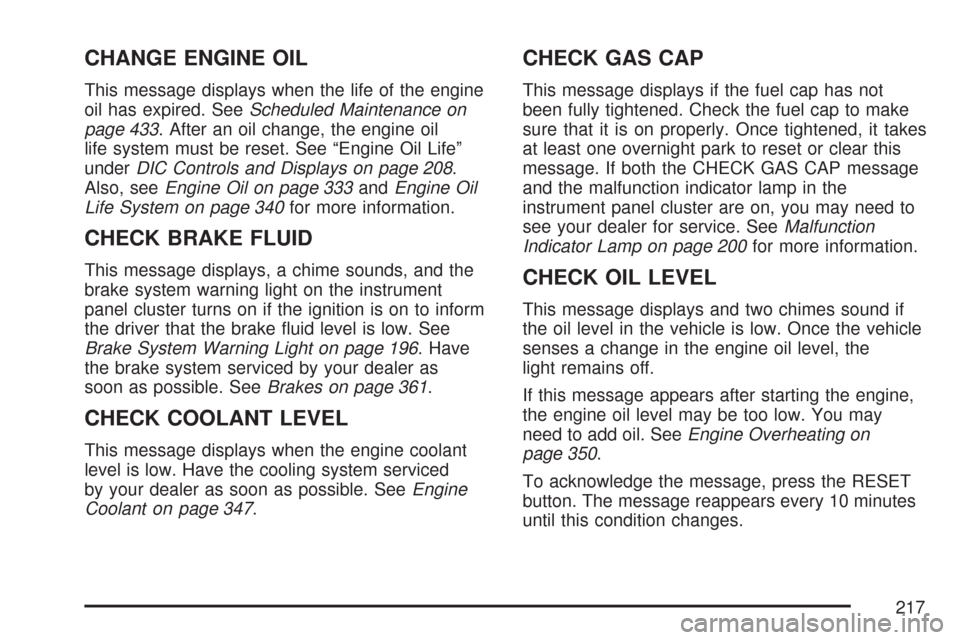
CHANGE ENGINE OIL
This message displays when the life of the engine
oil has expired. SeeScheduled Maintenance on
page 433. After an oil change, the engine oil
life system must be reset. See “Engine Oil Life”
underDIC Controls and Displays on page 208.
Also, seeEngine Oil on page 333andEngine Oil
Life System on page 340for more information.
CHECK BRAKE FLUID
This message displays, a chime sounds, and the
brake system warning light on the instrument
panel cluster turns on if the ignition is on to inform
the driver that the brake �uid level is low. See
Brake System Warning Light on page 196. Have
the brake system serviced by your dealer as
soon as possible. SeeBrakes on page 361.
CHECK COOLANT LEVEL
This message displays when the engine coolant
level is low. Have the cooling system serviced
by your dealer as soon as possible. SeeEngine
Coolant on page 347.
CHECK GAS CAP
This message displays if the fuel cap has not
been fully tightened. Check the fuel cap to make
sure that it is on properly. Once tightened, it takes
at least one overnight park to reset or clear this
message. If both the CHECK GAS CAP message
and the malfunction indicator lamp in the
instrument panel cluster are on, you may need to
see your dealer for service. SeeMalfunction
Indicator Lamp on page 200for more information.
CHECK OIL LEVEL
This message displays and two chimes sound if
the oil level in the vehicle is low. Once the vehicle
senses a change in the engine oil level, the
light remains off.
If this message appears after starting the engine,
the engine oil level may be too low. You may
need to add oil. SeeEngine Overheating on
page 350.
To acknowledge the message, press the RESET
button. The message reappears every 10 minutes
until this condition changes.
217
Page 218 of 488
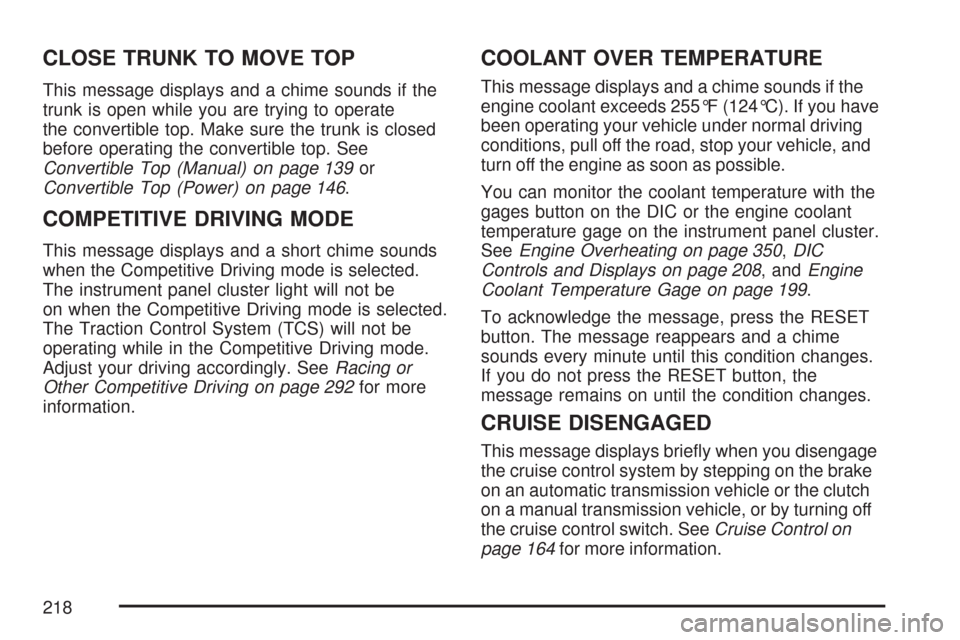
CLOSE TRUNK TO MOVE TOP
This message displays and a chime sounds if the
trunk is open while you are trying to operate
the convertible top. Make sure the trunk is closed
before operating the convertible top. See
Convertible Top (Manual) on page 139or
Convertible Top (Power) on page 146.
COMPETITIVE DRIVING MODE
This message displays and a short chime sounds
when the Competitive Driving mode is selected.
The instrument panel cluster light will not be
on when the Competitive Driving mode is selected.
The Traction Control System (TCS) will not be
operating while in the Competitive Driving mode.
Adjust your driving accordingly. SeeRacing or
Other Competitive Driving on page 292for more
information.
COOLANT OVER TEMPERATURE
This message displays and a chime sounds if the
engine coolant exceeds 255°F (124°C). If you have
been operating your vehicle under normal driving
conditions, pull off the road, stop your vehicle, and
turn off the engine as soon as possible.
You can monitor the coolant temperature with the
gages button on the DIC or the engine coolant
temperature gage on the instrument panel cluster.
SeeEngine Overheating on page 350,DIC
Controls and Displays on page 208, andEngine
Coolant Temperature Gage on page 199.
To acknowledge the message, press the RESET
button. The message reappears and a chime
sounds every minute until this condition changes.
If you do not press the RESET button, the
message remains on until the condition changes.
CRUISE DISENGAGED
This message displays brie�y when you disengage
the cruise control system by stepping on the brake
on an automatic transmission vehicle or the clutch
on a manual transmission vehicle, or by turning off
the cruise control switch. SeeCruise Control on
page 164for more information.
218
Page 224 of 488
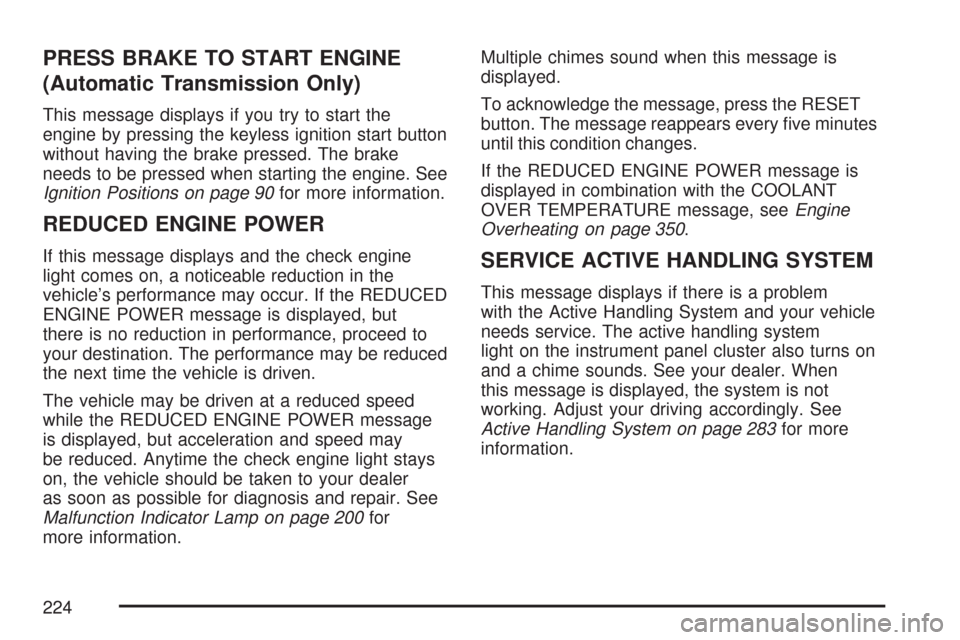
PRESS BRAKE TO START ENGINE
(Automatic Transmission Only)
This message displays if you try to start the
engine by pressing the keyless ignition start button
without having the brake pressed. The brake
needs to be pressed when starting the engine. See
Ignition Positions on page 90for more information.
REDUCED ENGINE POWER
If this message displays and the check engine
light comes on, a noticeable reduction in the
vehicle’s performance may occur. If the REDUCED
ENGINE POWER message is displayed, but
there is no reduction in performance, proceed to
your destination. The performance may be reduced
the next time the vehicle is driven.
The vehicle may be driven at a reduced speed
while the REDUCED ENGINE POWER message
is displayed, but acceleration and speed may
be reduced. Anytime the check engine light stays
on, the vehicle should be taken to your dealer
as soon as possible for diagnosis and repair. See
Malfunction Indicator Lamp on page 200for
more information.Multiple chimes sound when this message is
displayed.
To acknowledge the message, press the RESET
button. The message reappears every �ve minutes
until this condition changes.
If the REDUCED ENGINE POWER message is
displayed in combination with the COOLANT
OVER TEMPERATURE message, seeEngine
Overheating on page 350.SERVICE ACTIVE HANDLING SYSTEM
This message displays if there is a problem
with the Active Handling System and your vehicle
needs service. The active handling system
light on the instrument panel cluster also turns on
and a chime sounds. See your dealer. When
this message is displayed, the system is not
working. Adjust your driving accordingly. See
Active Handling System on page 283for more
information.
224
Page 225 of 488
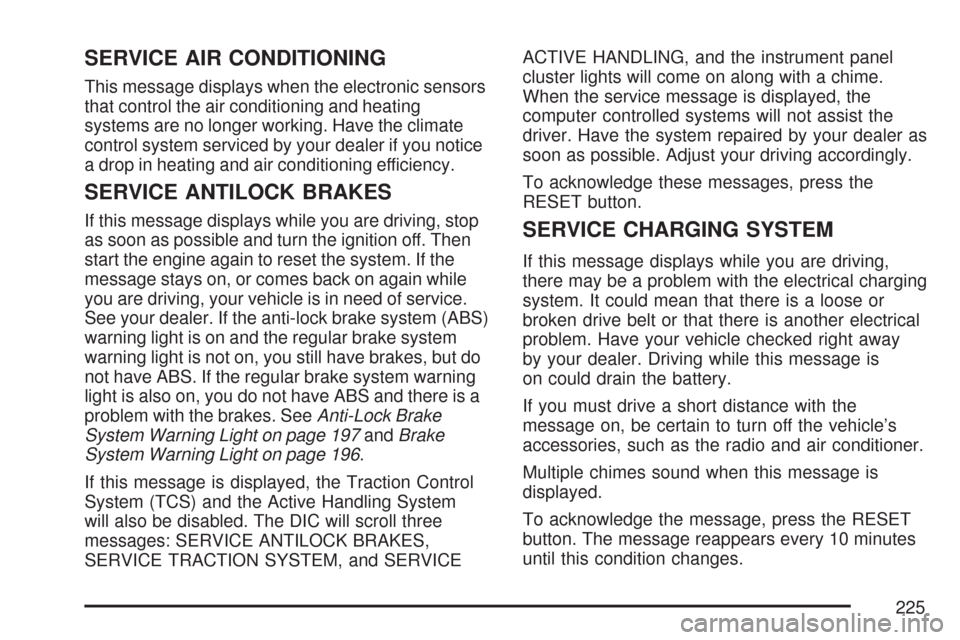
SERVICE AIR CONDITIONING
This message displays when the electronic sensors
that control the air conditioning and heating
systems are no longer working. Have the climate
control system serviced by your dealer if you notice
a drop in heating and air conditioning efficiency.
SERVICE ANTILOCK BRAKES
If this message displays while you are driving, stop
as soon as possible and turn the ignition off. Then
start the engine again to reset the system. If the
message stays on, or comes back on again while
you are driving, your vehicle is in need of service.
See your dealer. If the anti-lock brake system (ABS)
warning light is on and the regular brake system
warning light is not on, you still have brakes, but do
not have ABS. If the regular brake system warning
light is also on, you do not have ABS and there is a
problem with the brakes. SeeAnti-Lock Brake
System Warning Light on page 197andBrake
System Warning Light on page 196.
If this message is displayed, the Traction Control
System (TCS) and the Active Handling System
will also be disabled. The DIC will scroll three
messages: SERVICE ANTILOCK BRAKES,
SERVICE TRACTION SYSTEM, and SERVICEACTIVE HANDLING, and the instrument panel
cluster lights will come on along with a chime.
When the service message is displayed, the
computer controlled systems will not assist the
driver. Have the system repaired by your dealer as
soon as possible. Adjust your driving accordingly.
To acknowledge these messages, press the
RESET button.SERVICE CHARGING SYSTEM
If this message displays while you are driving,
there may be a problem with the electrical charging
system. It could mean that there is a loose or
broken drive belt or that there is another electrical
problem. Have your vehicle checked right away
by your dealer. Driving while this message is
on could drain the battery.
If you must drive a short distance with the
message on, be certain to turn off the vehicle’s
accessories, such as the radio and air conditioner.
Multiple chimes sound when this message is
displayed.
To acknowledge the message, press the RESET
button. The message reappears every 10 minutes
until this condition changes.
225
Page 230 of 488

TOO COLD TO MOVE TOP
This message displays and a chime sounds when
the power convertible top button is pressed and
the power convertible top pump motor temperature
is below -4°F (-20°C). Wait for the power
convertible top pump motor to warm up before
using the power convertible top.
TOP MOTOR OVER TEMPERATURE
This message displays and a chime sounds when
the power convertible top button is pressed and
the power convertible top pump motor temperature
is over 221°F (105°C). Wait for the power
convertible top pump motor to cool down before
using the power convertible top.
TOP NOT SECURE
This message displays and a chime sounds when
the power convertible top button is released
before the top open or close operation is complete
or if the top is closed without the header latch
engaged. Press and hold the convertible top button
to fully open or close the top, and make sure
that the header latch is engaged after the top is
closed.
TRACTION SYSTEM ACTIVE
This message displays when the Traction Control
System (TCS) is limiting wheel spin. Slippery
road conditions may exist if this message
is displayed, so adjust your driving accordingly.
The message stays on for a few seconds after the
TCS stops limiting wheel spin. SeeTraction
Control System (TCS) on page 281for more
information.
TRACTION SYSTEM AND ACTIVE
HANDLING – OFF
This message displays, the instrument panel
cluster light turns on, and a chime sounds when
the Traction Control System (TCS) and Active
Handling System are turned off by pressing
the Active Handling System button on the console
for �ve seconds. The Anti-lock Brake System
(ABS) remains on with the TCS and Active
Handling System off. Adjust your driving
accordingly. SeeTraction Control System (TCS)
on page 281andActive Handling System on
page 283for more information.
To acknowledge this message, press the RESET
button.
230
Page 278 of 488
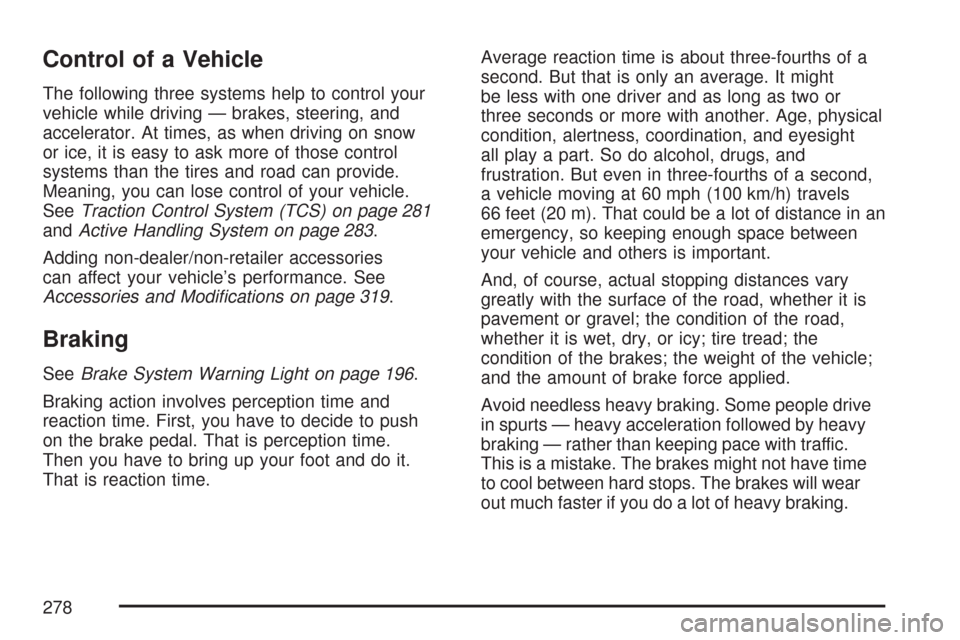
Control of a Vehicle
The following three systems help to control your
vehicle while driving — brakes, steering, and
accelerator. At times, as when driving on snow
or ice, it is easy to ask more of those control
systems than the tires and road can provide.
Meaning, you can lose control of your vehicle.
SeeTraction Control System (TCS) on page 281
andActive Handling System on page 283.
Adding non-dealer/non-retailer accessories
can affect your vehicle’s performance. See
Accessories and Modi�cations on page 319.
Braking
SeeBrake System Warning Light on page 196.
Braking action involves perception time and
reaction time. First, you have to decide to push
on the brake pedal. That is perception time.
Then you have to bring up your foot and do it.
That is reaction time.Average reaction time is about three-fourths of a
second. But that is only an average. It might
be less with one driver and as long as two or
three seconds or more with another. Age, physical
condition, alertness, coordination, and eyesight
all play a part. So do alcohol, drugs, and
frustration. But even in three-fourths of a second,
a vehicle moving at 60 mph (100 km/h) travels
66 feet (20 m). That could be a lot of distance in an
emergency, so keeping enough space between
your vehicle and others is important.
And, of course, actual stopping distances vary
greatly with the surface of the road, whether it is
pavement or gravel; the condition of the road,
whether it is wet, dry, or icy; tire tread; the
condition of the brakes; the weight of the vehicle;
and the amount of brake force applied.
Avoid needless heavy braking. Some people drive
in spurts — heavy acceleration followed by heavy
braking — rather than keeping pace with traffic.
This is a mistake. The brakes might not have time
to cool between hard stops. The brakes will wear
out much faster if you do a lot of heavy braking.
278